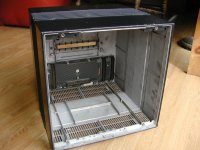NeXT
Veteran Member
Some Polish museum decided last night to say that Cube cases were formed using explosives because it was "to provide the accuracy and structure that satisfied Steve Jobs."
This reeks of RDF. Also It's been spoken for years that the cases are die-cast. Just because it's a magnesium alloy does not mean it wasn't possible in the mid-80's. GRiD did it. The cube case is actually three pieces that internally screw together.
Anyways I challenged them on this assumption and they come back with an excerpt from a memoir written by "Michael Darius". They didn't cite the book and I quickly checked and cannot find a book written by anyone with that name pertaining to Apple, NeXT or Steve Jobs.

All I can assume is that the casting process where the alloy is blown into the casting has been RDF'd into using explosives to shape it. Is there any other evidence behind this?
This reeks of RDF. Also It's been spoken for years that the cases are die-cast. Just because it's a magnesium alloy does not mean it wasn't possible in the mid-80's. GRiD did it. The cube case is actually three pieces that internally screw together.
Anyways I challenged them on this assumption and they come back with an excerpt from a memoir written by "Michael Darius". They didn't cite the book and I quickly checked and cannot find a book written by anyone with that name pertaining to Apple, NeXT or Steve Jobs.

All I can assume is that the casting process where the alloy is blown into the casting has been RDF'd into using explosives to shape it. Is there any other evidence behind this?
Last edited:

